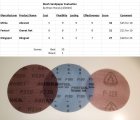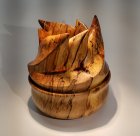Brian Horais
In Memoriam
I've been a fan of mesh sandpaper for a while now and began by using the Mirka Abranet product line. After a while, I decided to try some of the other brands, such as Klingspor Klingnet and Festool Granat Net to see which I would like the best. If you do a lot of irregular sanding, especially around complex curves and carved surfaces, I have found that the mesh sandpaper works very well because it is flexible, can be folded into shapes and can really get into the crevices. That said, which of these three brands works the best overall (in my opinion)? I did a quick spreadsheet (shown below) to evaluate the three brands and considered four factors: Cost, Flexibility, Wear resistance, and Overall effectiveness. If you consider cost, Abranet is by far the most expensive (nearly twice as much as Festool) and Klingspor is slightly less expensive than Festool. That said, I find the Abranet mesh sandpaper to be the most effective, with the best wear resistance (it lasts the longest) and has the best flexiblity. I often use only the mesh sandpaper, with no backing, so flexibility is important. The Festool tends to be thinner and does not work well without backing for the higher grits. Klingspor is the sturdiest, but least flexibile and wears out quickly on fold lines. Included is a picture of some 5 inch discs of the three brands of sandpaper. The open mesh allows sanding products to pass through and there is little buildup.
So what is my overall pick? You have probably guessed it by now: Mirka Abranet. It is more expensive (twice as much as Festool) but overall it gets the job done better and lasts longer. This outweighs the higher cost in my estimation.
What is your experience with mesh sandpaper and which brand do you find works best?
P.S. Isn't it amazing the tasks we can create when we have a lot of times on our hands....
So what is my overall pick? You have probably guessed it by now: Mirka Abranet. It is more expensive (twice as much as Festool) but overall it gets the job done better and lasts longer. This outweighs the higher cost in my estimation.
What is your experience with mesh sandpaper and which brand do you find works best?
P.S. Isn't it amazing the tasks we can create when we have a lot of times on our hands....


